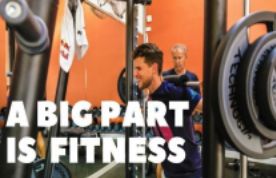Everything you ever wanted to know (or didn't) about tennis strength and conditioning - Part 1
- Raleigh Tennis
- Nov 20, 2020
- 3 min read
Tennis is one of the most popular sports on the planet (and the best but who’s asking). It is played on nearly every continent, on multiple surfaces, and by people of all ages. It is a sport that has fundamentally changed in regards to the equipment, ball type, surface speed, stroke mechanics, tactics, and much more in the last 100 years.
In the world of the ATP and WTA, there has been a steady increase in the utilization of Strength and Conditioning ("S&C") among top players. Do a quick search on players like Dominic Thiem, Grigor Dimitrov, Maria Sakkari, or Naomi Osaka training and you will come across a variety of videos showcasing box jumping, deadlifts, rack squats, and power cleans. Are they tennis players or Crossfit athletes??
However...the beliefs surrounding how we use strength and conditioning (S&C) in younger, competitive, and recreational tennis players often remain as antiquated as wooden racquets!
Ever heard of any of the following?

There are so many misconceptions to tackle! I am here today (and probably a few more times) to set the record straight on Strength and Conditioning and hopefully explain everything you ever wanted to know (or didn’t) about S&C.
Let’s get started with some Strength and Conditioning Myth Busting!!
MYTH #1: Strength Training Will Stunt My Child/Teen’s Growth
TRUTH #1: While overtraining can absolutely stunt growth… with a proper age-specific program, strength training improves bone health and stimulates metabolic changes!
MYTH #2: Lifting Weights Will Make Me Bulky
TRUTH #2: True…if you are training for bulk…a good periodized program combining endurance, strength, power and aerobic/anaerobic conditioning will improve lean muscle mass and strength.
MYTH #3: I Will Lose Speed If I Get Stronger
TRUTH #3: A proper tennis conditioning program will actually increase your agility and speed even with increases in strength/hypertrophy.
MYTH #4: Strength Training Will Affect Female Hormonal Levels So Should Be Avoided
TRUTH #4: This is a real possibility with OVERTRAINING. Hormonal levels in female athletes should always be monitored however…an age-appropriate program with proper load management and rest will actually improve hormonal health and bone density in females of all ages.
So now let’s get into S&C Terms to Know (Don’t worry about the training part yet, we will come back to it).

All of these are important in the world of athletics and exercise but each has to be trained differently depending on the demand of the sport.
You don’t train a linebacker and a figure skater the same way!!
Yet each of those athletes are “strong.” They demonstrate agility, endurance, and speed in their own respects. How you train these variables depends on the characteristics of the sport!

But quickly...let’s understand why we to need to train each of these variables specifically for tennis?
1. Strength
a. This one seems pretty obvious but strength has multiple roles in tennis
i. It is the platform for building power
ii. It begets flexibility (see my last post for a refresher on this)
iii. It protects your joints, tendons, and ligaments from injury
2. Hypertrophy
a. Proverbially known as “looking ripped” this one doesn’t tie in specific to function. Last I checked hypertrophy only accounts for about 25% increase in strength, but is something you will commonly see in strength programs and tends to signify leaner mass and better fitness

3. Power
a. Everyone wants more powerful strokes and serves but how do you get it? You train for power.
b. The faster you can exert a force the harder you will hit. It is that simple.
4. Endurance
a. Do you cramp up after an hour of play? Do you lose serve velocity in the 3rd set? Your endurance is likely lacking.
b. You can train both cardiac and muscular endurance (more later when we talk about energy systems).
5. Acceleration/Deceleration
a. Again fairly obvious how these play into tennis but did you know that most injuries occur due to a lack of deceleration control?
6. Agility
a. Probably the most important aspect of a good tennis player is how fast they can change directions and accelerate in the opposite direction (Rafael Nadal/Alex De Minaur anyone?)

Generally, most people have an idea that tennis players need these attributes but how do you train them just for tennis?
This leads us to the concept of specificity. In S&C, specificity in training is what translates into better performance and efficiency in a given sport.
So…let’s look specifically at what makes tennis…well…tennis.

A tennis S&C program should focus specifically (there is that word again) on training with respect to what you actually need in tennis!
So how do we do this? Stay Tuned!



